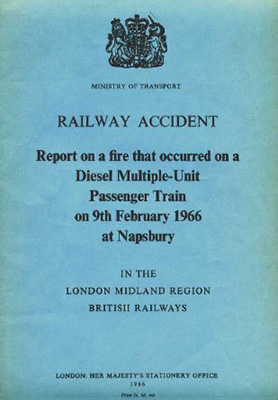DMU Accident
Napsbury, LMR - 09/02/66
Excessive wear in the torque convertors of the Class 127 units was being investigated by Rolls-Royce, and M51622 was fitted with various transducers along with measuring equipment located in the Guard's Compartment. One of the transducers was a strain gauge weighing 28lbs was fitted to the middle of the No.2 cardan shaft. The shaft carried the weight of the strain gauge which was fitted with restrainers to stop it rotating with the shaft.
Unfortunately, no-one gave a thought as to the stresses inflicted onto the shaft. It was later discovered that the Hardy Spicer 1800 shaft had a 'whirling' speed - the speed at which the shaft would bow (bend) and break-up - of 3100rpm, equivalent to a rail speed of 97mph. The additional weight of the transducer reduced this to around 67 mph.

The unit was placed into service and formed the 08:07 Harpenden to St. Pancras with M51622 being the fourth car with another unit to the rear. At 08:19 the shaft failed, rupturing the fuel tank and debris caused rupturing of the fuel tank on the following M51632. The train was engulfed in flames and smoke and 33 passengers required hospital treatment. Fortunately, the train came to a stand adjacent to Handley Page's airfield at Napsbury. Their chief test pilot had seen the train approaching, on fire, and called out the airfield fire tender which controlled the blaze until the arrival of the Fire Brigade.
An accident report was produced (the cover is pictured on the right), a pdf of the full report can be found on the Railways Archive website.
Both power cars would be repaired and returned to traffic.
Images

A number of photographs were taken after the incident, one of which can be seen in the accident report.
There were two sets of images, one taken by the London Midland Region "Public Relations & Publicity Dept." (not to publicise the incident but they were the ones called to documented events) in their DLxxxx series and the other by Derby Works (stamped British Railways Board Mechnical Engineer (Design) Derby) in their numberical 66/xxx series (the first two digits of this series was the year).
The typed sheet illustrated accompanied the images I obtained, it lists many of the images included below but also shows there were others. It is thought there would be a second page which would have listed more in the DL series to include the images here not listed. The sheet is dated 22nd February, which means all the images were taken before that date.
DLxxx series images (LMR Publicity Department)
These were taken at Cricklewood depot probably within a few days of the fire.

Negative DL3835
The exterior of M51632 showing the fire damage. The vehicle coupled to it on the left is presumably M51622.

Negative DL3836
This is thought to be vehicle M51622, it shows the rear passenger saloon above where the no.2 cardan shaft would have been, looking to the rear of the vehicle (the van is through the solid bukhead).

Negative DL3839
This is thought to be vehicle M51622, it shows the rear passenger saloon above where the no.2 cardan shaft would have been, looking towards the cab.

Negative DL3840
The underneath of a centre car, thought to be 59625. The small box on the back of the battery box has been dislodged, as has the conduit leading to it.

Negative DL3842
Fire damage on Class M51632. The battery box is on the left, fuel tank behind, electrical boxes to the right.

Negative DL3843
Fire damage on Class M51632. The box upper right contains the B.I.S. (battery isolation switch), beneath is an exhaust silencer.

Negative DL3844
The underneath of a centre car, thought to be 59625. The accident report noted that "the alternator case had been struck" on that vehicle.

Negative DL3846
Underframe equipment on either M51622 or M51632. It shows a Smiths heater with an engine behind and a radiator to the right. Damage includes disintegrated heater intake ducting and scorching to the cable between the heater and the vehicle and to the insulation on the closest end of the heater.

Negative DL3848
The fire-damaged side of M51632. Most of the scorching of the bodyside is above the battery box. Note all the broken windows to the centre of the vehicle.

Negative DL3850
This is believed to be the underside of M51632. The accident report noted "Nos. 1 and 2 fuel tanks had both been punctured one in the side and the other underneath". The fuel tank in the image seems to have damage on the underside.

Negative DL3851
This is believed to be the underside of M59625 on which the accident report noted "received damage to the vacuum reservoir tank" which is evident in the photo.
66/xxx series images (Derby Works)
These only featured the damaged components.

Negative 66/176
"No.2 cardan shaft from railcar M51622 superimposed on full size sketch of surrounding equipment".

Negative 66/178
"Portion of fractured cardan shaft (No.2), bearing slip-ring assembly, from railcar M.51622".










